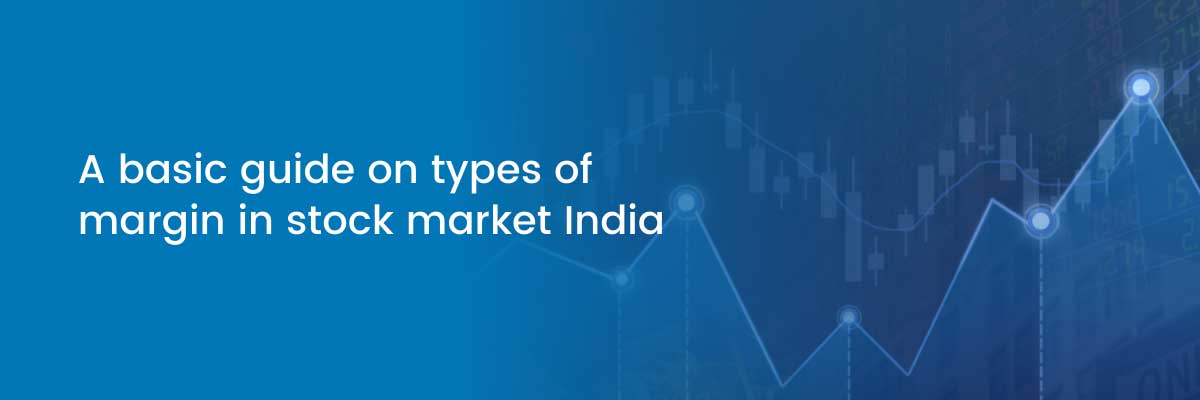If you’re deep into learning about finance and investments, you may have come across the term margin in share market at some point. In fact, you probably came across it many times. So, what exactly is margin within finance and the stock market? What about margin in the stock market of India? We’ll get to that eventually. Let’s start with the first question.
First things first.
What is margin in stock market?
In the simplest of terms, it is the collateral that an investor deposits to their broker or stock exchange to cover the credit risk that the investor poses for the broker or the stock exchange.
If that seems confusing, think of it as this – say you want to buy some shares. Business transactions may take time and there might be the slight possibility that you aren’t able to pay the entire cash required for all the shares you’re purchasing. In this case, you pay a part of the money.
Why should there be Margin?
Suppose an investor, purchases 1000 shares of ‘XYZ company at Rs.100/- on January 1, 2021. The investor has to give the purchase amount of Rs.1,00,000/- (1000 x 100) to his broker on or before January 2, 2021. Broker, in turn, has to give this money to the stock exchange on January 3, 2021.
There is always a small chance that the investor may not be able to bring the required money by the required date. As an advance for buying the shares, the investor is required to pay a portion of the total amount of Rs.1,00,000/- to the broker at the time of placing the buy order.
Stock exchange in turn collects a similar amount from the broker upon execution of the order. This initial token payment is called MARGIN. Remember, for every buyer, there is a seller and if the buyer does not bring the money, the seller may not get his / her money.
Because, share prices fluctuate on the daily. If prices go down at the end of the same day, for example, then there is a loss suffered. If the margin is paid, then the loss can be covered. Margin in share market is a method of both ensuring that the investor is serious in buying the shares, and that the broker can mitigate the risk of losses.
Now we can move on to the next question.
What are the types of margins in the stock market?
Specifically, we will talk about the types of margins in the stock market and within the futures and options (F&O) market.
- First, let’s look at the cash market margins.
What is Value at Risk Margin (VaR Margin)
VaR is a statistic quantifying the extent of possible loss that might occur when dealing with securities within a particular time-frame. To make it easier to understand, think of it as a measure of how much the price of a security is likely to move over the next day. In this type, the margin is collected on an upfront basis. VaR is a technique where historical volatility in stock prices is used to estimate the probability of loss in the value of an asset or group of assets. A VaR margin is a margin that is intended to cover the largest lost that may be faced by a buyer for their shares within a single day and is collected on an upfront basis.
Extreme Loss Margin (ELM)
ELM aims at covering losses that could occur outside the cover of VaR margins. It is the margin blocked in addition to the VaR margin and is fixed at the beginning of every month using price data of the previous six months.
Market to Market Margin (MTM Margin)
MTM Margin is calculated at the end of the day on all open positions by comparing transaction price with the closing price of the share price of the day. This is charged by the broker to cover the additional risk of daily price movements.
- Next, we have the margins within the F&O market.
Initial margin is calculated on a collection of futures and option positions using an extensively used software called SPAN. SPAN uses a scenario-based approach to arrive at margins, and generates various scenarios by assuming different values to prices and volatility, as they are constantly changing. A possible loss is calculated for each of the scenarios and the buyer pays the highest loss that is calculated upfront.
Exposure Margin
The second type of margin within the F&O market is the exposure margin which is collected in addition to the initial margin and are fixed percentages of the face value of the stock. The percentage is also different for futures and options.
Details:-
| PRODUCT |
EXTREME LOSS MARGIN |
| Index Derivatives |
2% of the notional value |
| Stock Derivatives |
3.5% of the notional value |
For this purpose, notional value means:
- For a futures contract - the contract value at the last traded price/closing price.
- For a short options contract – the value of the underlying index or the value of an equivalent number of underlying shares as conveyed by the short options contract, in the underlying market, based on the last available closing price.
The margin on consolidated crystallized obligation
The margin on consolidated crystallized obligation in derivatives represents:
|
ON INTRADAY BASIS |
crystallized obligations based on the closed-out futures positions and it is payable/receivable premium at the client level. |
| AT END-OF-DAY |
Obligations at client level considering all futures and options positions. |
Intraday basis:
On an intraday basis, the net payable/receivable amount at the client level is:
- The premium payable/receivable.
- Futures crystallized profit or loss (calculated based on weighted average prices of trades executed).
If the overall amount at the client level is payable, such amount is the intraday consolidated crystallized obligation margin for the client.
End-of-day basis At the end of the day, the payable/receivable amount at the client level shall be calculated using:
- Futures mark to market profit/loss to be settled
- Options premium payable/receivable
- Options exercise/assignment for expired contracts
- Futures final settlement for expired contracts
If the overall amount at the client level is payable, such amount is the end-of-day consolidated crystallized obligation margin for the client. The margin on consolidated crystallized obligations shall be released on completion of settlement.
MTM (Mark-To-Market) Losses:
Mark to market loss is calculated by marking each transaction in security to the closing price of the security at the end of trading. The mark to market margin (MTM) is collected from the member before the start of the trading of the next day. At every End of the day, the difference of the cost bought/sold vs Closing price calculated and the Loss so on the said position is considered as MTM loss.
Delivery margins for Physical Settlement in Equity Derivatives:
Any outstanding position in the Equity Derivatives converts and marked to Delivery on Expiry date if it is still outstanding. It is also called a Delivery Margin on Physical Settlement. The exchange has mandated that long call and put options will require margins to be blocked. These margins are called Delivery margins and will be applicable from 4 days before expiry. The delivery margin would be released once the physical settlement process is completed.
PEAK MARGIN
With the guideline issued by SEBI, Brokers need to collect upfront margins in the form of funds/securities by way of Fund transfer or Margin Pledge (Specifically read as Clear Funds &/or Securities) to execute any transactions. It has primarily to restrict from providing additional leverage over and above what VAR+ELM ( with minimum 20% for stocks) and SPAN + Exposure (F&O – Equity, Commodity, Currency) already offer.
Starting Dec 1st, 2020, the maximum intraday leverage that can be offered by a broker will be restricted and this maximum leverage will keep reducing until Sep1’st 2021 post which a broker can give maximum leverage = VAR+ELM(min 20%) or SPAN+Exposure. Until now, the reporting for margin requirements happened based on end-of-day positions.
Based on these positions, the exchange was imposing a margin on the customer. Under peak margin reporting, Exchange shall send 4 Snapshots in a day on scheduled time (In a random, system-driven process). At the end of the day, Exchange will consider the maximum margin across that 4 snapshots/Margin files for any client which will be considered as Peak Margin.
Calculation:
EOD margin obligation of the client shall be compared with the respective client margin available with the TM/CM at EOD.
Peak margin obligation of the client/TM/Custodial Participant, across the snapshots, shall be compared with respective client/TM/Custodial Participant peak margin available with the TM/CM during the day
Higher the shortfall in collection of the margin obligations at (a) and (b) above, shall be considered for levying of penalty as per the extant framework.
Dec 2020 to Feb 2021 — Penalty if margin blocked is less than 25% of the minimum 20% of trade value (VAR+ELM) for stocks or SPAN+Exposure for F&O.]
- March 2021 to May 2021 — penalty if margin blocked less than 50% of the minimum margin required.
- June 2021 to Aug 2021 — penalty if margin blocked less than 75% of the minimum margin required.
- Sept 2021 — penalty if margin blocked less than 100% of the minimum margin required.
Aside from the two mentioned above, buyers of options also have to pay a premium margin, which is paid by the buyers of the options contracts and is equal to the value of the option’s premium times the quantity of options purchased. Additionally, there’s an assignment margin collected on assignment from the sellers of the contracts.
Finally, we hope this article has been able to clearly point out some of the most important categories of margins available to buyers and investors within the various stock markets in India.








_6072fe75b5885.jpg)